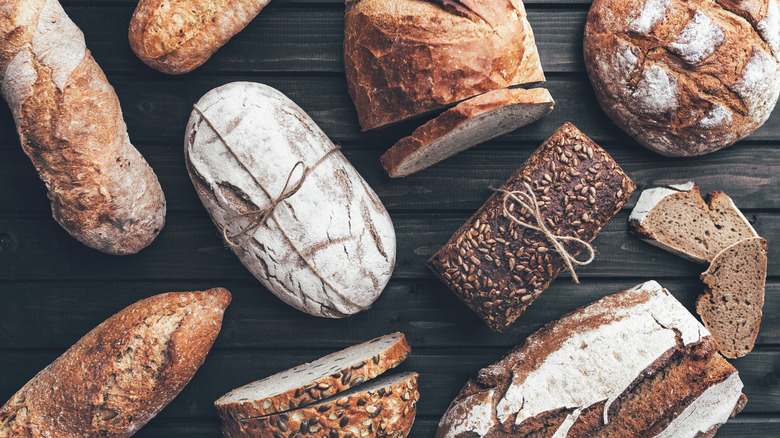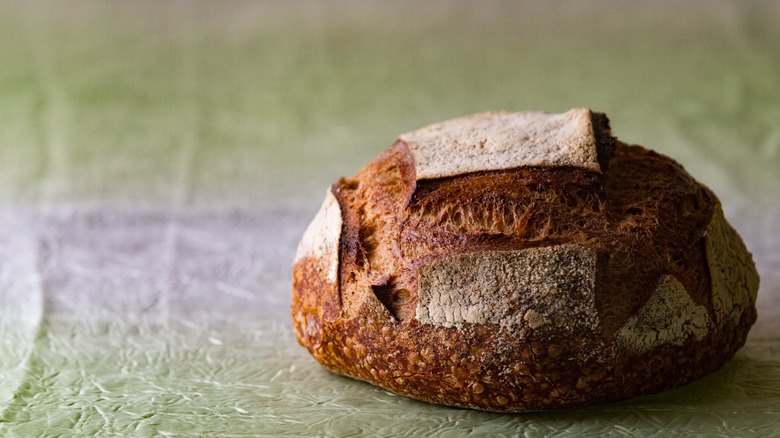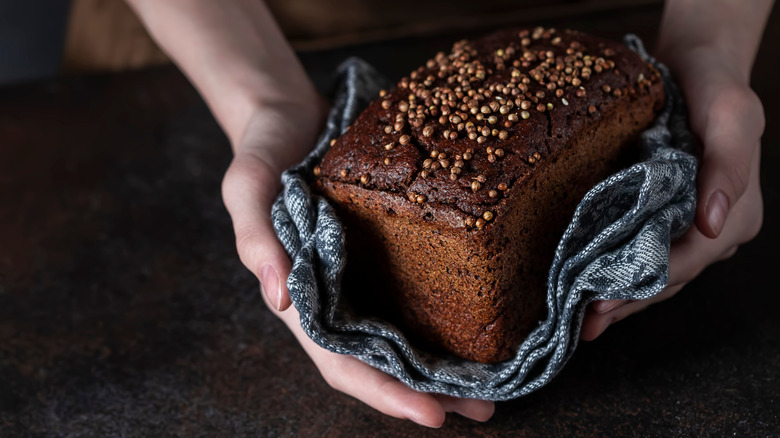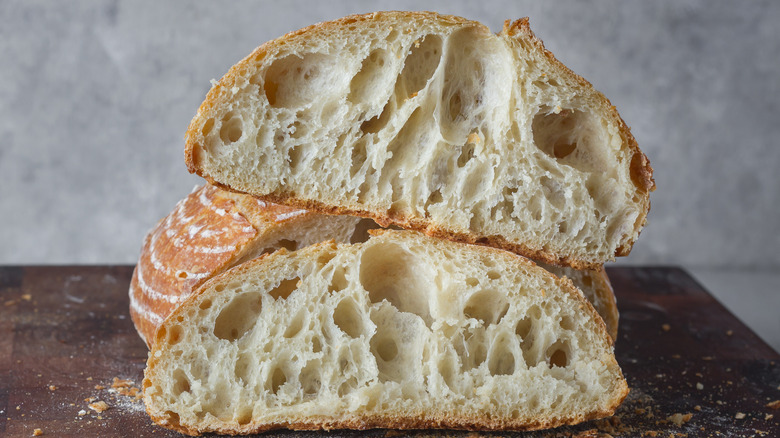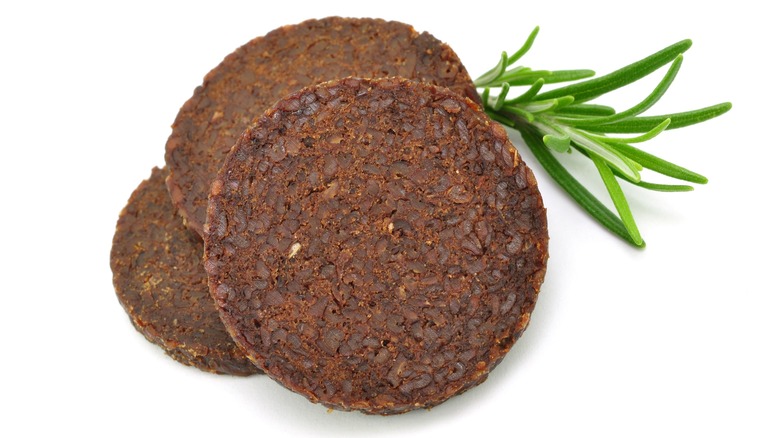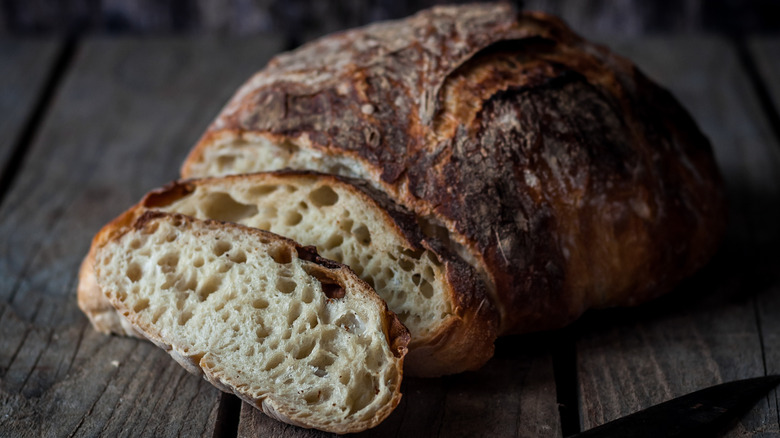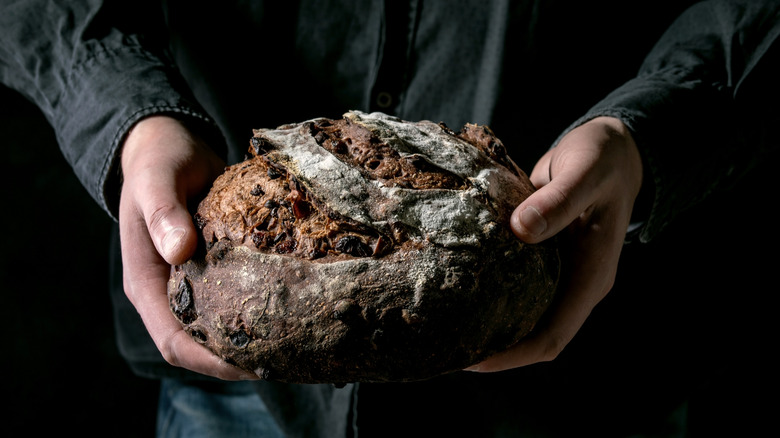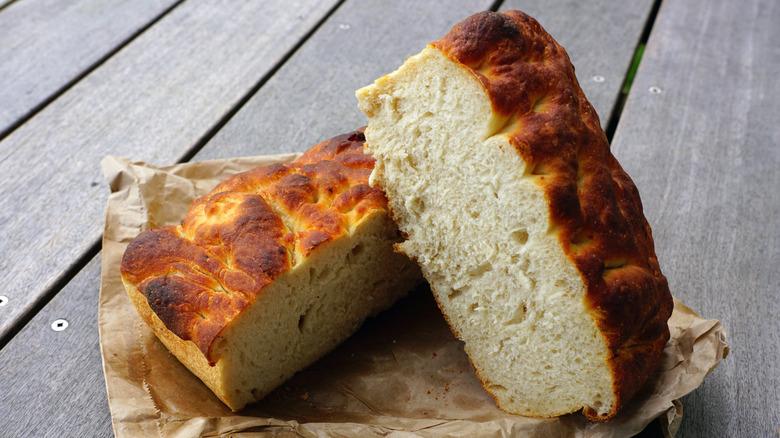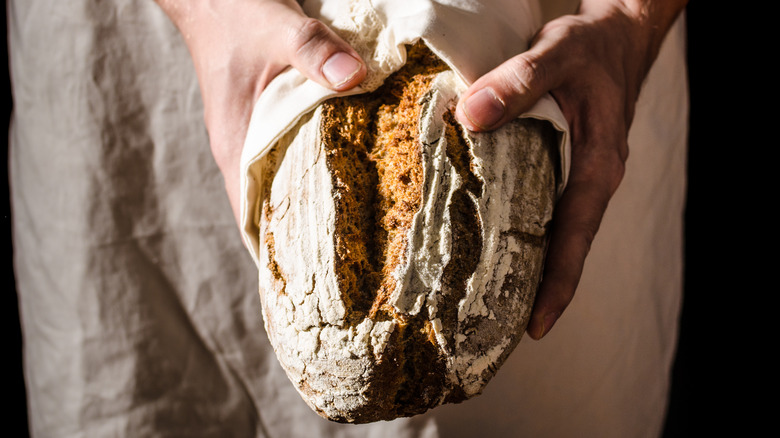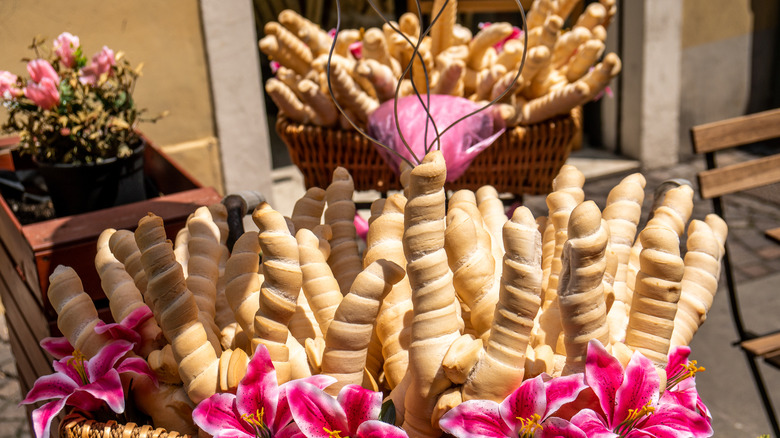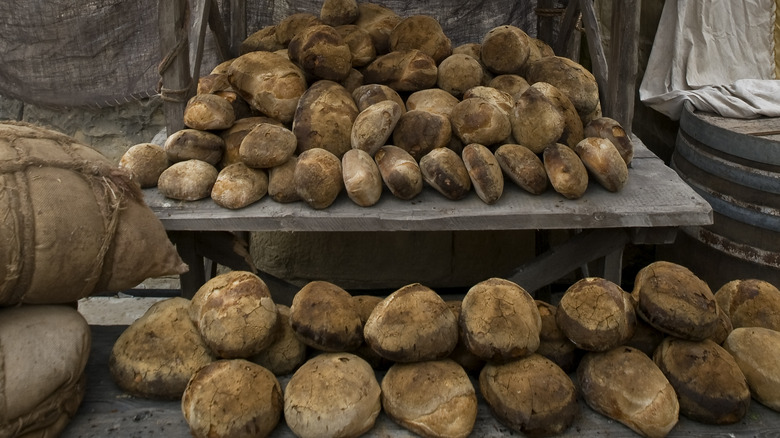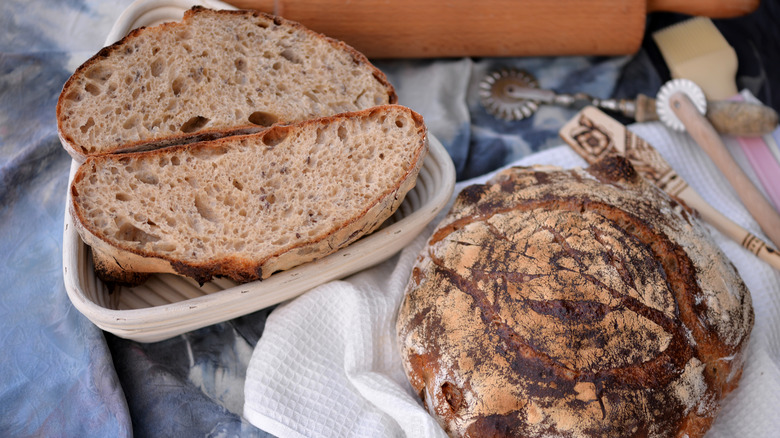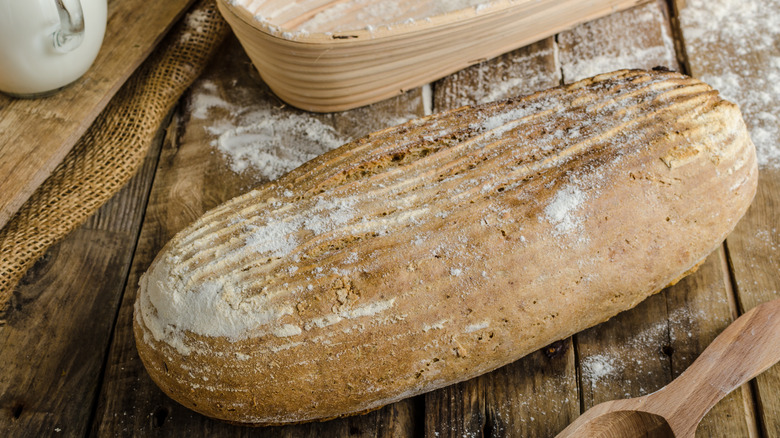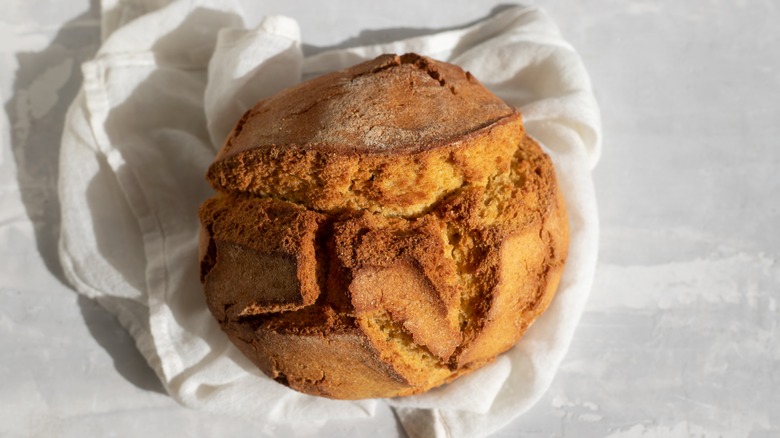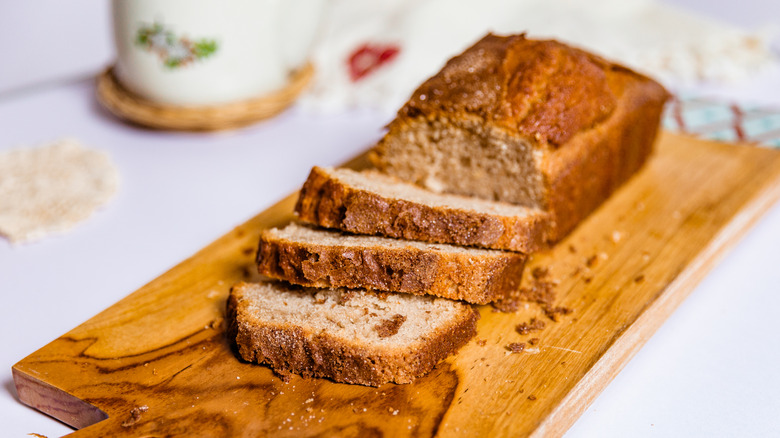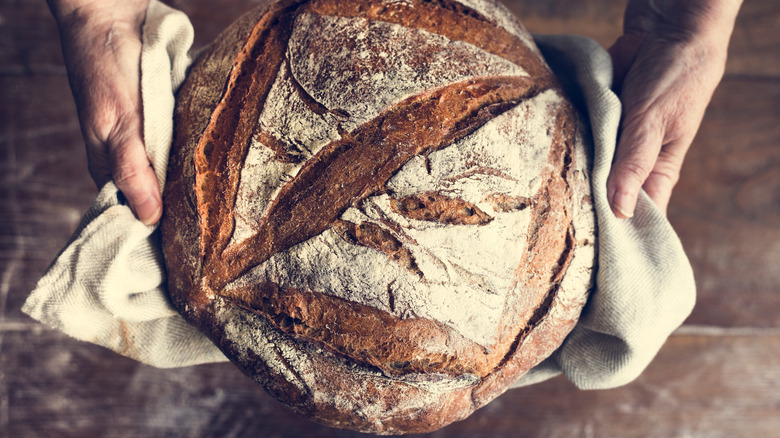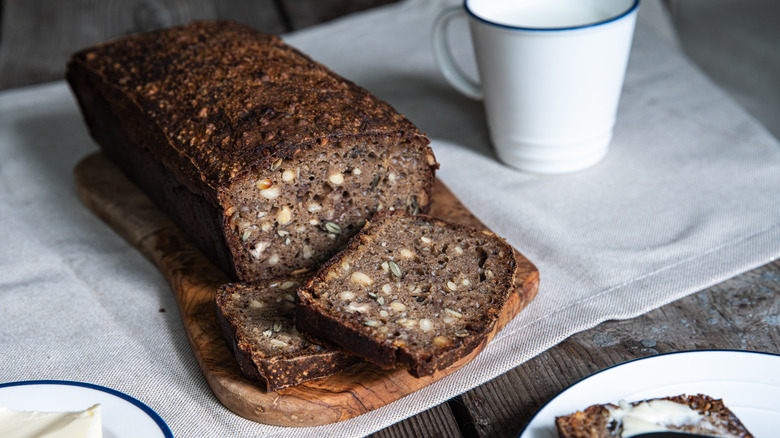16 Types Of Sourdough Bread And What Makes Them So Different
Sourdough is a type of leavened bread made with a starter — a combination of flour and water left to ferment slowly. This type of bread does not use any commercial yeast or additives, and it rises due to wild yeast and good bacteria in the starter culture. Along with a bubbly and ripe starter, sourdough bread requires only three ingredients: flour, water, and salt (via BBC Good Food). Though it may seem as if sourdough is just a recent foodie trend, this could not be further from the truth. Sourdough is one of the ancient bread types and is most likely the original form of leavened bread familiar to the Egyptians. It is often considered superior in texture, flavor, and nutritional value to your standard yeast loaf (via Bakerpedia).
BBC Good Food explains that sourdough can be made with any flour and is an excellent base for additional ingredients and flavorings, which naturally results in numerous varieties. Apart from savory bread, sourdough starters are sometimes used for sweet baked goods. Italian fruit-studded panettone is probably the most famous sweet representative, traditionally made with a stiff starter called pasta madre.
This list mostly includes savory varieties that are defined by ingredients and some traditional regional practices, resulting in a colorful collection of sourdoughs showcasing the extent of creativity in sourdough baking.
San Francisco sourdough bread
San Francisco sourdough is often listed as a unique variety, but this distinction has nothing to do with the type of flour, its shape, or a particular bread-making technique. What makes it stand out is the unique symbiosis of yeast and bacteria. As CBS News reports, San Francisco sourdough has a distinctive sour flavor because of Lactobacillus sanfranciscensis, a bacteria native to the region that reacts well with Candida milleri yeast, resulting in bread with a unique flavor profile that cannot be recreated anywhere else. Since its discovery in the 1970s, the bacteria has been found in around 90 other countries, but as bread-maker Josey Baker shared with BBC, San Francisco soudough still manages to result in a unique, sour-flavored bread due to the acetic acid that develops during fermentation.
National Geographic explains that sourdough bread from San Francisco is distinguished for its chewy texture and rustic crust, which make it stand out among mediocre supermarket versions. One of the most popular places for San Francisco sourdough is the Boudin Bakery — claiming to serve the Original San Francisco Sourdough. At Boudin, the bakers use the original mother dough from 1849, which is the base for its tart and chewy sourdoughs.
Borodinsky bread
Borodinsky is a rye-based sourdough bread mainly associated with Russia and former Soviet countries. Russia Beyond describes it as spicy but also sweet and sour, claiming that you may not find anything quite like it. The bread usually combines rye and wheat, along with molasses and coriander seeds, resulting in a bread with a crispy exterior and a soft center. Bench And Bowl shares an intricate story of how this bread came to life, explaining that it was the first standardized bread in the Soviet Union. The first versions were 100% rye as wheat was too pricey and usually reserved for pastries and for more expensive loaves.
Pants Down Aprons On provides his version of the bread, saying that though rye starter is mostly used, it can be replaced with other starters or even yeast. The combination of ingredients results in a flavorful bread with a soft and moist texture. The chef explains that this bread is mainly used for open-faced sandwiches and can be paired with various toppings. Baketo Bakery suggests cutting the loaf into thin slices and skipping the toasting step to get the best out of this rye sourdough.
Classic white-flour sourdough
White-flour sourdough is one of the traditional sourdoughs and is usually part of the standard offer at bakeries. Many home bakers also start their sourdough journey with this variety, as it does not call for unusual or hard-to-find ingredients, apart from an active starter. The base of every white sourdough is white flour, which has the wheat bran and the wheat germ stripped from the wheat grain, leaving only the endosperm part of the grain to be ground into flour (via True Sourdough).
Although white flour lacks the nutrients concentrated in the bran and the germ, it is the most reliable baking flour, ideal for sourdough beginners, as it is easy to handle and usually gives consistent results. Sourdough made with white flour will produce soft, subtly sour bread with large air pockets. Bread flour (also known as strong flour in the U.K.) is the best option for white sourdough as it produces a lot of gluten, providing elasticity and structure (via True Sourdough).
White-flour sourdough can be shaped either as a round boule or the elongated batard loaf. Though white flour should remain dominant, it's perfectly acceptable to add small amounts of other types of flour to impart additional flavor components.
Pumpernickel
Pumpernickel is a rich and dense rye-based bread that originates from Westphalia, a region in northwestern Germany. This bread is traditionally made with a starter. It is usually 100% rye and made with coarse rye flour. However, it should not be called rye bread, as the term can encompass numerous bread varieties that incorporate different types of flour, leavening agents, or other additions (via MasterClass).
Traditional pumpernickel will have a distinctive dark color due to the amount of rye used in the dough. The texture of the bread is firm but crumbly. Pumpernickel bread lacks the typical crispy crust as the whole loaf remains soft and moist. The flavor is complex, subtly sweet, and earthy (via Foodal).
Pumpernickel is best served thinly sliced. Pair it with smoked salmon or roast beef or ham slices, or top it with sweet and savory toppings; think of honey and butter, orange marmalade, creamy horseradish or hummus (via Foodal). Remember that the word pumpernickel is loosely used in the U.S., and the process and ingredients can significantly differ from traditional practices (via MasterClass).
No-knead sourdough bread
No-knead bread is a less finicky and technically less demanding bread that can result in an excellent, well-risen loaf. Although the no-knead technique has been used for hundreds of years, it gained traction in 2006 when bakery owner Jim Lahey shared his no-knead bread recipe in The New York Times. As soon as it was published, the story started a global trend that popularized the technique as an excellent option for home bakers.
As sourdough bread is infamous for its somewhat fussy and time-consuming method, it may surprise you that it can also be made as a no-knead version. Though you can exclude heavy hand work from the process, reserving enough time is essential to get a decent no-knead sourdough. Leaving the dough to rise and ferment will help in gluten development (usually attained with kneading) and allow the bread to achieve a distinctive sour flavor. The final result is a well-risen bread with a good crumb and crispy crust (via MasterClass). Lahey shared an even quicker version with Bloomberg, allowing you to make, bake, and enjoy a slice of sourdough on the same day.
Chocolate sourdough bread
Chocolate is a versatile ingredient. Though we mostly think of it in the realm of sweets and candies, chocolate has multiple personalities. It can be used as an excellent ingredient in savory bakes. When talking about chocolate sourdough, we mainly refer to cocoa powder as the ingredient providing the chocolate-like flavor.
Adding cocoa to sourdough bread will result in dark-colored bread with intense flavors reminiscent of dark chocolate. You can add a twist by including other ingredients, as this bread will pair well with nuts, spices, or dry fruit (via MasterClass). The Clever Carrot suggests adding chocolate chips, while baker Josh Axler flavors his version with hot chocolate, claiming that this is the most decadent bread you will ever taste.
If you embark on this chocolate-fueled sourdough journey, you can get a basic chocolate sourdough starter to elevate the chocolate experience. As explained, cocoa will provide a delicious background flavor, and the starter can be used for any bread.
Maori potato bread
Rewena paraoa is the original name for the traditional potato bread of the Maori, an indigenous group of people in New Zealand (via Bread Therapy). The bread is categorized as sourdough, but unlike some conventional bread-and-water starters, this Maori version uses a starter, also known as bug, made with fermented potatoes. The technique is time-consuming and quite challenging to perfect, but it gives the bread a nice rise and a distinctive flavor (via The New Zealand Herald).
The starter for the bread is made with mashed potatoes, flour, sugar, and water. It is left to ferment naturally, creating a bubbly sourdough starter that is incorporated into the dough. The ingredients produce a somewhat different sourdough version that does not have the typical open crumb but rather a firmer, thicker texture. The flavor is only faintly reminiscent of potatoes, but the starter provides subtle sweetness to the loaves that can later be used as an accompaniment or a base for sweet and savory toppings (via Summer Bakes the World).
Spelt sourdough bread
Spelt is one of the ancient grains that was only recently reintroduced as a mainstream baking ingredient, mainly because of its numerous health benefits. Spelt sourdough bread can be made with white or whole-grain spelt flour. Because spelt flour is naturally low in gluten, the bread dough can't really hold shape as there isn't enough gluten development, but adding strong bread flour can be an excellent option to produce nice gluten structure and well-risen bread. Water percentage can also be tricky as spelt-based dough requires less water than standard wheat sourdough (via Bakerpedia).
MasterClass recommends spelt sourdough as an excellent option for sandwiches and claim that the bread is soft, with a nice crumb and crispy crust. The Sourdough School describes it as a tasty and crispy sourdough with a denser texture than what is usually expected in sourdough bread. The bread is sweet and has a nutty flavor.
Coppia Ferrarese bread
Coppia Ferrarese is a traditional sourdough bread from Ferrara, Italy. The bread has a protected status, meaning it can only be made in the province of Ferrara and with strictly defined ingredients. The base of every coppia Ferrarese is the mother yeast (starter) that is combined with flour, water, lard, extra virgin olive oil, salt, and malt. The dough is shaped into two rolls that are then twisted and connected in the center to create an unusual cross or horn-like shape (via Qualigeo).
The first written references of Coppia Ferrarese date back to the 16th century (via Emilia Romagna Turismo). The unusual shape has remained its most distinctive feature, but it is also unique for its texture. The protruding horns, known as crostini, are the crunchy part, while the center (where the dough connects) remains soft. Coppia is a perfect accompaniment to charcuterie, but it also works great with local sauces and stews as the crunchy tips are ideal for dipping, according to Emilia Romagna Turismo.
Maltese sourdough bread
Maltese bread is a rustic, country-style bread considered an indispensable part of Maltese culinary tradition. Locally known as hobz Malti, the bread is available in several varieties, and it is made with a starter, which classifies it as sourdough (via European Cuisines). The bread is typically round, with a dark and crispy crust. It is traditionally baked in wood-fired ovens (Guide Me Malta).
This bread is also a favorite among tourists, who often buy loaves as a souvenir. As Matthew Mangion, who runs a traditional bakery in the town of Qormi, shared with The Malta Independent, the bread should have a crispy crust, while the center should remain soft, dotted with larger and smaller holes. The staff at Lovin Malta provides a decent list of all the ways you can devour this delicious sourdough if, by chance, you get tired of eating it as a standard bread. The suggestions include making a crunchy bruschetta or turning it into a sweet bread pudding. Guide Me Malta suggests the traditional version paired with tomatoes and olive oil.
Whole-wheat sourdough bread
As the name implies, whole-wheat sourdough is a type of bread made with whole-wheat flour — which uses the entire wheat berry. Unlike standard white flour, which contains only the endosperm of the grain, whole wheat also includes the bran and the germ. Apart from being a healthier version, when used in sourdough baking, whole-wheat flour will result in slightly different bread. As this flour has less gluten, the structure of the bread will probably be less firm than the one in white-flour sourdough. The texture will be dense, with a less open crumb, but the taste and the aroma will be more powerful and complex (via Bakerpedia).
Bakers often mix whole-wheat flour and white flour to get a flavorsome, light bread with a nice open crumb. The combination allows them to preserve the complexity of the flavor and the nutty fragrance, but at the same time, get a light and less dense bread that will have a finer, open crumb (via True Sourdough).
Sourdough beer bread
As beer and sourdough are both fermented products made with similar ingredients, we can safely say they are close cousins. Apart from that, they also make great partners in bread baking. Some standard sourdough recipes will feature a starter, flour, and salt, together with water as the liquid element that will hydrate the flour and provide moisture. Surprisingly, you can swap water for a bubbly glass of your favorite beer. The Pantry Mama uses beer instead of water for her classic sourdough recipe. The fermentation process didn't show significant differences, but the aroma was strong and distinctively yeasty. The beer-like notes fade after baking, but the bread is more complex. It has a thinner crust and retains a subtle beer flavor, The Pantry Mama notes.
If you are up for a bubbly experiment, Foodgeek shows how using different beer styles in sourdough baking results in distinct breads. The beer style will affect the color, the crust, and the crumb of sourdough bread. He describes the aroma as "bready" and "hoppy," while the taste test shows that the breads will undoubtedly carry a characteristic flavor reminiscent of the type of beer used in the process.
Portuguese corn sourdough bread
Broa de milho is a cornbread traditional in northern Portugal, where corn was commonly used as an alternative because wheat wasn't suitable for the regional climate (via Ark of Taste). The bread may combine corn and buckwheat flour, and it is always naturally leavened, which officially makes it a sourdough. In the past, it was usually baked in traditional stone ovens. It comes out as a golden loaf with a thick, cracked crust, dense crumb, and caramel-like flavor (via Ark of Taste).
Breadtopia provides what it suggests is a more common combination with corn flour and rye flour. Corn is still dominant, while rye provides rich, earthy qualities. Foodgeek offers another option that replaces buckwheat and rye with standard bread flour. Corn will impart some sweetness, and the bread will still have the typically closed crumb with small air pockets. Ark of Taste recommends pairing this heavy and substantial bread with delicacies, such as anchovies or fried stockfish. Those at 196 Flavors suggest that this traditional sourdough works best with hearty soups or simply smeared with butter and served with olives.
Amish friendship bread
Technically, Amish friendship bread would better fit in the cake category, but it is included in the list as most people still refer to it as bread. This cake-like bread is also unique because of its story — the starter that combines flour, sugar, milk, water, and yeast is fermented, and as you use one portion to make the bread, you divide the rest among friends or family members, hence the friendship moniker. The bread has uncertain origins, and it is questionable whether it was created by the Amish, but it was a big hit in the U.S. throughout the 1980s (via NPR).
Although the recipe can significantly vary, Friendship Bread Kitchen has the supposed original version of this sweet bread. It has a standard base with eggs, milk, starter, sugar, flour, and oil, while the flavorings include vanilla and cinnamon. Raisins and nuts give the bread some texture, and the list of ingredients also features vanilla-flavored instant-pudding mix that should provide moisture and subtle vanilla notes. The bread is sweet and aromatic, and as it is topped with cinnamon sugar, it has a delicious crispy cover. Despite numerous variations, this bread is traditionally baked as a loaf.
Pain de campagne
Pain de campagne is a country-style French sourdough. The bread is usually made with white or whole-wheat flour grain, sometimes with the addition of rye. As it is simple and rustic, it does not require many ingredients and only includes flour, water, and salt, along with the sourdough starter that gives the bread volume. Although not complicated, the bread is hearty and flavorsome (via The Bread She Bakes). Pain de campagne is usually round, and each piece is scored. In the past, when it was baked in communal ovens, the scores indicated to whom the bread belonged (via Cook's Info).
Pain de campagne has a thick crust. The crumb is dense, and the flavor is only faintly sour, which makes it different from other sourdough versions (via Le Cordon Bleu). Because of its subtle flavor and good texture, it is a great vessel for jams and makes excellent sandwich bread (via MasterClass).
Danish rye
Rugbrød is a rye-based bread from Denmark that has a distinctive dark color and unique, coarse texture. Although it is sourdough bread, it differs from the light and airy loaf that you might associate with the name and has more in common with dense and moist Central European bread styles (via Foodgeek). Along with rye flour, this bread is packed with seeds and coarse rye that provide an interesting textural element and make the bread nutritious (via Nordic Food & Living). As Foodgeek explains, the whole grains make the bread rich in fiber and without many carbohydrates, meaning that it will keep you filled for longer.
Rugbrød is traditionally baked in rectangular bread or cake pans and is often eaten smeared with butter. It is best known as the standard bread for smørrebrød — Scandinavian open-faced sandwiches that can be topped with various ingredients. Rugbrød has a long shelf life, and the thin slices can also be dried and enjoyed as crackers (via Breadtopia).
